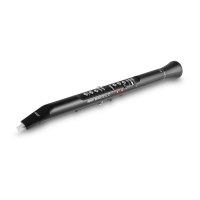
Do you have a question about the Akai EWI Solo and is the answer not in the manual?
| Type | Electronic Wind Instrument |
|---|---|
| Effects | Reverb, Delay, Chorus |
| Note Range | 8 Octaves |
| Pitch Bend | Yes |
| Vibrato | Yes |
| Sound Engine | Built-in Sound Engine |
| Sounds | 200 sounds |
| Connectivity | USB |
| Power | Rechargeable battery or USB power |
| Control | breath sensor |
| Octave Rollers/Keys | Octave rollers |
| Display | OLED display |
| Included Accessories | USB cable |
Accessing product information and support resources.
Steps for powering on and holding the EWI Solo.
Connecting to amplifiers, interfaces, and headphones.
Using the EWI Solo as a MIDI controller.
Advice on vibrato, articulation, and hand contact.
Using note keys, octave rollers, glide, and pitch-bend plates.
Core playing interface and its adjustability.
Functions of Hold and Interval buttons for performance.
Using the display and encoder for operation.
Buttons for managing programs and effects.
Buttons for accessing and saving favorite programs.
Grounding plates, octave rollers, glide, and pitch-bend plates.
USB port, audio outputs, power button, battery compartment.
How to choose and load instrument sounds.
Storing custom programs in Favorites lists.
Detailed settings for the Reverb effect.
Detailed settings for the Chorus effect.
Adjusting Breath, Bite, Glide, and Pitch Bend sensors.
Configuring Hold and Interval button behavior.
MIDI, Speaker, Idle Shutdown, and Font Size.
Offset, Sensitivity, Learn Mode, and Capture Delay.
MIDI output types: Breath CC, Lock Velocity, Constant Output.
Sensitivity, filter, and output mode for bite sensor.
Key delay, sensitivity, and K10 function adjustments.
EWI, Saxophone, Flute, Oboe, EVI, and Reverse EVI modes.
Portamento, Legato Time, and Custom CC modes.
Pitch Bend and Custom CC configurations.
Off, Legato, Non-legato, and Custom CC modes.
Harmony and Custom CC modes for interval button.
LFO, MIDI Channel, Speaker, Idle Shutdown, Font Size.
Procedure for resetting to factory defaults.
Battery care, replacement, and disposal.